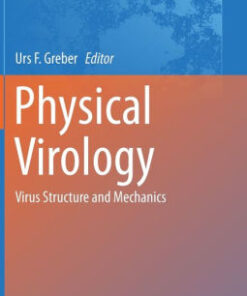(PDF) Introduction to Modern Virology 7th Edition by Nigel J. Dimmock
$18.00
Download instantly Introduction to Modern Virology 7th Edition by Nigel J. Dimmock, Andrew J. Easton, Keith N. Leppard. It is ebook in PDF format.
ISBN-10: 1119978106 ISBN-13: 9781119978107
Preview
This is the PDF eBook version for Introduction to Modern Virology 7th Edition by Nigel J. Dimmock, Andrew J. Easton, Keith N. Leppard
Table of Contents
Preface xvii
About the companion website xix
PART I THE NATURE OF VIRUSES 1
Chapter 1 Towards a definition of a virus 3
1.1 Discovery of viruses 4
1.2 Multiplication of viruses 5
1.3 The virus multiplication cycle 6
1.4 Viruses can be defined in chemical terms 7
1.5 Multiplication of bacterial and animal viruses is fundamentally similar 10
1.6 Viruses can be manipulated genetically 11
1.7 Properties of viruses 11
1.8 Origin of viruses 12
Key points 12
Further reading 12
Chapter 2 The structure of virus particles 13
2.1 Virus particles are constructed from subunits 13
2.2 The structure of filamentous viruses and nucleoproteins 14
2.3 The structure is of isometric virus particles 15
2.4 Enveloped (membrane-bound) virus particles 24
2.5 Virus particles with head-tail morphology 27
2.6 Frequency of occurrence of different virus particle morphologies 28
2.7 Principles of disassemply: virus particles are metastable 28
Key points 29
Further reading 29
Chapter 3 Classification of viruses 30
3.1 Classification on the basis of disease 30
3.2 Classification on the basis of host organism 31
3.3 Classification on the basis of virus particle morphology 31
3.4 Classification on the basis of viral nucleic acids 32
3.5 Classification on the basis of taxonomy 34
3.6 Satellites, viroids and prions 35
Key points 37
Further reading 38
Chapter 4 The evolution of viruses 39
4.1 Mechanisms of virus evolution 40
4.2 The potential for rapid evolution: mutation and quasispecies 40
4.3 Rapid evolution: recombination 43
4.4 Rapid evolution: reassortment 43
4.5 Evolution to find a host, and subsequent co-evolution with the host 46
Key points 51
Questions 51
Further reading 51
Chapter 5 Techniques for studying viruses 52
5.1 Culturing wild virus isolates 52
5.2 Enumeration of viruses 54
5.3 Measuring infectious virus titres 55
5.4 Measuring physical virus titres 57
5.5 Detecting virus in a sample 58
5.6 Understanding virus replication cycles 62
5.7 Viral genetics and reverse genetics 63
5.8 Systems-level virology 63
Key points 65
Questions 65
Further reading 65
PART II VIRUS GROWTH IN CELLS 67
Chapter 6 The process of infection: I. Virus attachment and entry into cells 69
6.1 Infection of animal cells: the nature and importance of receptors 69
6.2 Infection of animal cells: enveloped viruses 73
6.3 Infection of animal cells: non-enveloped viruses 78
6.4 Infection of plant cells 80
6.5 Infection of bacteria 81
6.6 Infection of cells: post-entry events 82
6.7 Virus entry: cell culture and the whole organism 84
Key points 84
Questions 84
Further reading 85
Chapter 7 The process of infection: IIA. The replication of viral DNA 86
7.1 The universal mechanism of DNA synthesis 87
7.2 Replication of circular double-stranded DNA genomes 90
7.3 Replication of linear double-stranded DNA genomes that can form circles 93
7.4 Replication of linear double-stranded DNA genomes that do not circularize 96
7.5 Replication of single-stranded circular DNA genomes 100
7.6 Replication of single-stranded linear DNA genomes 100
7.7 Dependency versus autonomy among DNA viruses 103
Key points 103
Questions 103
Further reading 103
Chapter 8 The process of infection: IIB. Genome replication in RNA viruses 105
8.1 Nature and diversity of RNA virus genomes 106
8.2 Regulatory elements for RNA virus genome synthesis 106
8.3 Synthesis of the RNA genome of Baltimore class 3 viruses 111
8.4 Synthesis of the RNA genome of Baltimore class 4 viruses 111
8.5 Synthesis of the RNA genome of Baltimore class 5 viruses 115
8.6 Synthesis of the RNA genome of viroids and hepatitis delta virus 118
Key points 119
Questions 119
Further reading 119
Chapter 9 The process of infection: IIC. The replication of RNA viruses with a DNA intermediate and vice versa 121
9.1 The retrovirus replication cycle 122
9.2 Discovery of reverse transcription 122
9.3 Retroviral reverse transcriptase 123
9.4 Mechanism of retroviral reverse transcription 125
9.5 Integration of retroviral DNA into cell DNA 128
9.6 Production of retrovirus progeny genomes 130
9.7 Spumaviruses: retrovirus with unusual features 131
9.8 The hepadnavirus replication cycle 131
9.9 Mechanism of hepadnavirus reverse transcription 131
9.10 Comparing reverse transcribing viruses 134
Key points 134
Questions 134
Further reading 135
Chapter 10 The process of infection: IIIA. Gene expression in DNA viruses and reverse-transcribing viruses 136
10.1 The DNA viruses and retroviruses: Baltimore classes 1, 2, 6 and 7 137
10.2 Polyomaviruses 138
10.3 Papillomaviruses 142
10.4 Adenoviruses 144
10.5 Herpesviruses 147
10.6 Poxviruses 149
10.7 Parvoviruses 149
10.8 Retroviruses 150
10.9 Hepadnaviruses 153
10.10 DNA bacteriophages 154
Key points 154
Questions 155
Further reading 155
Chapter 11 The process of infection: IIIB. Gene expression and its regulation in RNA viruses 156
11.1 The RNA viruses: Baltimore classes 3, 4 and 5 157
11.2 Reoviruses 158
11.3 Picornaviruses 163
11.4 Alphaviruses 164
11.5 Coronaviruses 166
11.6 Negative sense RNA viruses with segmented genomes 169
11.7 Orthomyxoviruses 169
11.8 Arenaviruses 173
11.9 Negative sense RNA viruses with non-segmented, single stranded genomes: rhabdoviruses and paramyxoviruses 174
Key points 177
Questions 178
Further reading 178
Chapter 12 The process of infection: IV. The assembly of viruses 179
12.1 Self-assembly from mature virion components 180
12.2 Assembly of viruses with a helical structure 180
12.3 Assembly of viruses with an isometric structure 184
12.4 Assembly of complex viruses 187
12.5 Sequence-dependent and -independent packaging of virus DNA in virus particles 189
12.6 The assembly of enveloped viruses 190
12.7 Segmented virus genomes: the acquisition of multiple nucleic acid molecules 194
12.8 Maturation of virus particles 195
Key points 196
Questions 197
Further reading 197
PART III VIRUS INTERACTIONS WITH THE WHOLE ORGANISM 199
Chapter 13 Innate and intrinsic immunity 201
13.1 Innate immune responses in vertebrates – discovery of interferon 202
13.2 Induction of type 1 interferon responses 203
13.3 Virus countermeasures to innate immunity 207
13.4 TRIM proteins and immunity 209
13.5 Intrinsic resistance to viruses in vertebrates 210
13.6 Innate and intrinsic immunity and the outcome of infection 212
13.7 RNAi is an important antiviral mechanism in invertebrates and plants 212
13.8 Detecting and signalling infection in invertebrates and plants 214
13.9 Virus resistance mechanisms in bacteria and archaea 215
Key points 216
Questions 217
References 217
Chapter 14 The adaptive immune response 218
14.1 General features of the adaptive immune system 219
14.2 Cell-mediated immunity 221
14.3 Antibody-mediated humoral immunity 226
14.4 Virus evasion of adaptive immunity 232
14.5 Age and adaptive immunity 233
14.6 Interaction between the innate and adaptive immune systems 233
Key points 234
Questions 236
Further reading 236
Chapter 15 Interactions between animal viruses and cells 237
15.1 Acutely cytopathogenic infections 238
15.2 Persistent infections 238
15.3 Latent infections 241
15.4 Transforming infections 243
15.5 Abortive infections 243
15.6 Null infections 244
15.7 How do animal viruses kill cells? 244
Key points 246
Questions 247
Further reading 247
Chapter 16 Animal virus–host interactions 248
16.1 Cause and effect: Koch’s postulates 248
16.2 A classification of virus–host interactions 249
16.3 Acute infections 252
16.4 Subclinical infections 253
16.5 Persistent and chronic infections 254
16.6 Latent infections 256
16.7 Slowly progressive diseases 257
16.8 Virus-induced tumours 258
Key points 259
Questions 260
Further reading 260
Chapter 17 Mechanisms in virus latency 261
17.1 The latent interaction of virus and host 261
17.2 Gene expression and the lytic and lysogenic life of bacteriophage ? 263
17.3 Herpes simplex virus latency 270
17.4 Epstein-Barr virus latency 274
17.5 Latency in other herpesviruses 275
17.6 HIV-1 latency 277
Key points 277
Questions 278
Further reading 278
Chapter 18 Transmission of viruses 279
18.1 Virus transmission cycles 279
18.2 Barriers to transmission 281
18.3 Routes of horizontal transmission in animals 282
18.4 Vertical transmission 285
18.5 Vector-borne viruses and zoonotic transmission 287
18.6 Epidemiology of virus infections 289
18.7 Sustaining infection in populations 290
Key points 291
Questions 291
Further reading 291
PART IV VIRUSES AND HUMAN DISEASE 293
Chapter 19 Human viral disease: an overview 295
19.1 A survey of human viral pathogens 295
19.2 Factors affecting the relative incidence of viral disease 297
19.3 Factors determining the nature and severity of viral disease 299
19.4 Common signs and symptoms of viral infection 301
19.5 Acute viral infection 1: gastrointestinal infections 302
19.6 Acute viral infection 2: respiratory infections 304
19.7 Acute viral infection 3: systemic spread 306
19.8 Acute viral disease: conclusions 306
Key points 307
Questions 308
Further reading 308
Chapter 20 Influenza virus infection 309
20.1 The origins of human influenza viruses 309
20.2 Influenza virus replication 315
20.3 Influenza virus infection and disease 316
20.4 Virus determinants of disease 321
20.5 Host factors in influenza virus disease 322
20.6 The immune response and influenza virus 323
20.7 Anti-influenza treatment 324
Key points 325
Questions 326
Further reading 326
Chapter 21 HIV and AIDS 327
21.1 Origins and spread of the HIV pandemic 327
21.2 Molecular biology of HIV 330
21.3 HIV transmission and tropism 338
21.4 Course of HIV infection: pathogenesis and disease 339
21.5 Immunological abnormalities during HIV infection 342
21.6 Prevention and control of HIV infection 343
Key points 345
Questions 346
Further reading 346
Chapter 22 Viral hepatitis 347
22.1 The signs and symptoms of hepatitis 347
22.2 Hepatitis A virus infections 349
22.3 Hepatitis E virus infections 350
22.4 Hepatitis B virus infections 352
22.5 Hepatitis D virus infections 355
22.6 Hepatitis C virus infections 356
Key points 359
Questions 361
Further reading 361
Chapter 23 Vector-borne infections 362
23.1 Arboviruses and their hosts 362
23.2 Yellow fever virus 363
23.3 Dengue virus 367
23.4 Chikungunya virus 369
23.5 West Nile virus in the USA 372
Key points 375
Questions 375
Further reading 375
Chapter 24 Exotic and emerging viral infections 376
24.1 Ebola and Marburg viruses: emerging filoviruses 377
24.2 Hendra and Nipah viruses: emerging paramyxoviruses 381
24.3 SARS and MERS: emerging coronaviruses 383
24.4 Predicting the future: clues from analysis of the genomes of previously unknown viruses 386
Key points 386
Questions 386
Further reading 387
Chapter 25 Carcinogenesis and tumour viruses 388
25.1 Immortalization, transformation and tumourigenesis 389
25.2 Oncogenic viruses 390
25.3 Polyomaviruses, papillomaviruses and adenoviruses: the small DNA tumour viruses as experimental models 394
25.4 Papillomaviruses and human cancer 398
25.5 Polyomaviruses and human cancer 399
25.6 Herpesvirus involvement in human cancers 400
25.7 Retroviruses as experimental model tumour viruses 402
25.8 Retroviruses and naturally-occurring tumours 404
25.9 Hepatitis viruses and liver cancer 405
25.10 Prospects for the control of virus-associated cancers 406
Key points 407
Questions 408
Further reading 408
Chapter 26 Vaccines and immunotherapy: the prevention of virus diseases 409
26.1 The principles of vaccination 411
26.2 Whole virus vaccines 412
26.3 Advantages, disadvantages and difficulties associated with whole virus vaccines 415
26.4 Subunit vaccines 420
26.5 Advantages, disadvantages and difficulties associated with subunit vaccines 421
26.6 Considerations for the generation and use of vaccines 422
26.7 Adverse reactions and clinical complications with vaccines 423
26.8 Eradication of virus diseases by vaccination 425
26.9 Immunotherapy for virus infections 428
26.10 Adverse reactions and clinical complications with immunotherapy 429
Key points 429
Questions 430
Further reading 430
Chapter 27 Antiviral therapy 431
27.1 Scope and limitations of antiviral therapy 431
27.2 Antiviral therapy for herpesvirus infections 432
27.3 Antiviral therapy for influenza virus infections 434
27.4 Antiviral therapy for HIV infections 435
27.5 Antiviral therapy for hepatitis virus infections 439
27.6 Therapy for other virus infections 440
Key Points 441
Questions 441
Further Reading 442
Chapter 28 Prion diseases 443
28.1 The spectrum of prion diseases 443
28.2 The prion hypothesis 444
28.3 The aetiology of prion diseases 447
28.4 Prion disease pathogenesis 448
28.5 Bovine spongiform encephalopathy (BSE) 451
28.6 BSE and the emergence of variant CJD 453
28.7 Concerns about variant CJD in the future 454
28.8 Unresolved issues 455
Key points 456
Questions 456
Further reading 456
PART V VIROLOGY – THE WIDER CONTEXT 459
Chapter 29 The economic impact of viruses 461
29.1 The economics of virus infections of humans 462
29.2 The economics of virus infections of animals 464
29.3 The economics of virus infections of plants 466
29.4 The Netherlands tulip market crash 469
Key points 470
Further reading 470
Chapter 30 Recombinant viruses: making viruses work for us 472
30.1 Recombinant viruses as vaccines 473
30.2 Recombinant viruses for gene therapy 474
30.3 Retroviral vectors for gene therapy 476
30.4 Adenovirus vectors for gene therapy 478
30.5 Parvovirus vectors for gene therapy 480
30.6 Oncolytic viruses for cancer therapy 480
30.7 Recombinant viruses in the laboratory 482
Key points 482
Questions 482
Further reading 483
Chapter 31 Viruses: shaping the planet 484
31.1 Virus infections can give a host an evolutionary advantage 484
31.2 Endogenous retroviruses and host biology 485
31.3 Bacteriophage can be pathogenicity determinants for their hosts 488
31.4 Cyanophage impacts on carbon fixation and oceanic ecosystems 488
31.5 Virology and society: for good or ill 489
Key points 490
Questions 490
Further reading 490
Index 491




